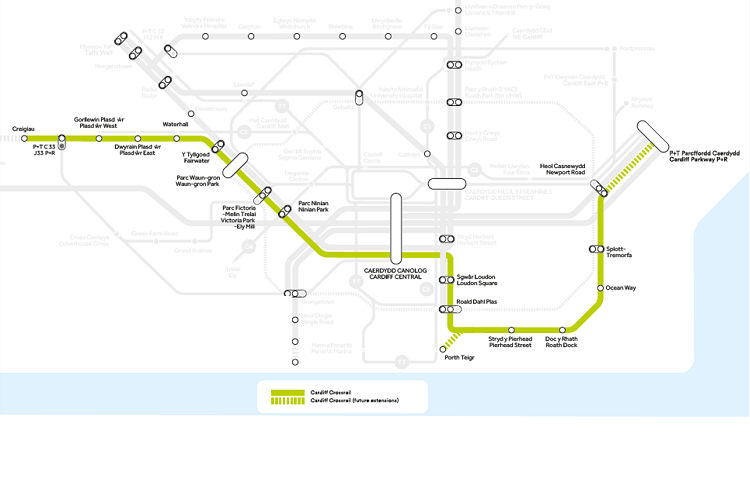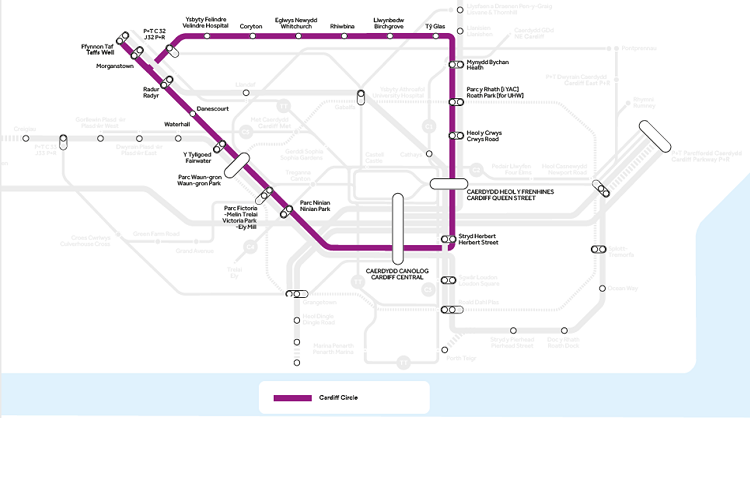In this week's Transport column, Professor Mark Barry explores the emerging vision for Transport in Cardiff, with particular attention to the Cardiff Crossrail.
Core to Cardiff’s emerging transport vision is the incremental development of a Rapid Transit Network.

Fig. 1 – Proposed Cardiff Rapid Transit Network
This network will augment the new stations and services proposed as part of the South Wales Metro, exploit tram-train technology and make use of existing and new rail corridors. These rail-based interventions will be integrated with new bus priority corridors, a redesigned bus network and active travel measure to dramatically enhance public transport and active travel accessibility across the city.
I’ll focus on the Cardiff Crossrail & Circle lines here.
Cardiff Crossrail
Core to the emerging vision of Cardiff Council is the incremental development of a “Cardiff Crossrail” using tram-train technology being introduced as part of the South Wales Metro. This will be the essential foundation of an ambitious long-term programme to encourage more public transport use across the city.

Figure 13 Illustration of a potential Cardiff Crossrail
There are 4 distinct sections which can be phased:
1. Cardiff Central/Lloyd George Avenue (LGA)/Cardiff Bay to provide a direct connection between Cardiff Bay and Cardiff Central
The application of tram-trains on the bay line can be a catalyst for a major landscaping and regeneration project – A Greenway. Greenway projects re-purpose older industrial artefacts in cities to form new community spaces combining green space, active travel and public transport with community regeneration and development projects.
Learning from examples like the Arbutus Greenway in Vancouver[ii], Cardiff Council could repurpose the existing bay line corridor incorporating some new development but also green spaces and active travel routes.
2. Cardiff West Junction & City Line
This section requires early action to address the network constraint at Cardiff West to enable at least 4tph on City Line, more services to VoG/Penarth and to enable a later extension to NW Cardiff. It will also provide major network benefits (increased capacity and redundancy) as it enables an alternative high capacity route from the valley lines into Central Station and to the bay (avoiding Queen St).
A new station can also be introduced at Victoria Park/Ely Mill and the role of Waungron Park as a bus interchange will become much more important with this improved rail services offering. This section will also include a link between the city line at the western end of Cardiff Central to the extended bay line (#1 above) to Cardiff Central.
3. Wales Millennium Centre (WMC) to Rover Way/Newport Rd (including the potential to connect to Porth Teigr).
A new station at Rover Way will interchange with main line rail services and support a bus interchange for access to the east of the city. The service could also be extended on the relief lines to Cardiff Parkway and beyond. This section requires a new link from the WMC across pierhead street through the docks to an upgraded Tidal Sidings freight line which can also support additional stations including Splott/Tremorfa and at/near Ocean Way in an area that it poorly served by rail and is also in the top 10% of WIMD.
4. NW Cardiff extension to RCT from the City Line
This is an entirely new section that can be phased and serve the new housing at PlasDwr, support a major P&R at M4 J33 and run through Creigiau and onto Rhondda Cynon Taf (RCT) via Talbot Green to Pontyclun; a potential for a spur to Beddau can also be considered. This route provides an opportunity to develop complementary higher density housing and mixed-use schemes using Transit Oriented Development principles along the entire route.
Complementary Schemes: Cardiff Circle & Tram-train to Penarth

Figure 14 Illustration of potential Cardiff Circle line
To complement the Crossrail proposals and to deliver better E-W connectivity across the north of the city a new connection between the Coryton Line and Radyr/Taffs Well is proposed to create a Cardiff Circle Figure 14
- Once network capacity issues are addressed it will be possible to operate tram-trains to Penarth to allow extension to Lower Penarth/Cosmeston
Benefits
There are a wide range of benefits that can be secured from the development of a rapid transit network in Cardiff. Perhaps the most important are:
- Most importantly the provision of a public transport service able to sustainably support mobility for a city of over 400,000 people at the heart of a developing city region 1.6M people
- Improved cross city connectivity and accessibility of parts of Cardiff (especially when combined with major bus interchanges and a redesigned bus network) suffering economic challenges (including Splott, Tremorfa and Ely which are in the top 10% of Welsh Index of Multiple Deprivation (WIMD)
- Development and community regeneration across the southern arc of Cardiff from PlasDwr, Fairwater and Ely in the west through Central Quay, Butetown and Cardiff Bay to Tremorfa, Splott, Rover Way and Cardiff Parkway in the east; as well as Gabalfa, Forest Farm, Roath Park and Heath Hospital in the north.
- Addressing transport constraints associated with the PlasDwr development and helping bring forward further Transit Oriented Development (TOD) along the route into RCT (all the way via Talbot Green to Pontyclun).
- Transforming the Bay Line into an urban park via a regeneration and development project that can fully integrate Butetown into the wider city
- A direct metro connection between Cardiff Bay and Cardiff Central
- A major Park & Ride at M4J33
- Station based development and regeneration initiatives long the line
- Improved employment catchment of Newport, Bridgend, Barry, Pontypridd.
Furthermore, by extending Cardiff Crossrail to Cardiff Parkway (and beyond) on the relief lines to the east, would support direct services (via tidal sidings) to the new arena proposed in Cardiff Bay.
Perhaps most strategically, addressing the rail network constraint at Cardiff West junction in Canton delivers more network capacity and redundancy to the lines into the valleys north of Cardiff and to Penarth and Barry on the Vale of Glamorgan line.
The Cardiff Circle proposal will also deliver better E-W connectivity across the north of the city and perhaps more importantly, help enhance the employment catchment of Merthyr, Pontypridd & Nantgarw as more of the significant population of north and north east Cardiff would be able to travel to those locations using public transport far more easily than is the case today.
Welsh Government and TfW need a pat on the back
We have to step back here and give credit where credit is due. Transport for Wales (TfW) did not exist until 2015. Yet less than three years later it had concluded the biggest and most complex procurement in Welsh Government (WG) history. That is pretty impressive and should tell us that we should not be so down on ourselves so much of the time – it’s a Welsh trait that is not always helpful!
I would also point out for the record that without devolution there would be no South Wales Metro or any prospect of a Cardiff Crossrail. Under the stewardship of the DfT and UK Government schemes like this just don’t happen. I covered this broader powers and lack of rail investment issue for WG in 2018 in ,”The Case for Investment”.[iii]
Therefore, Welsh Government and TfW are to be congratulated for pushing the South Wales Metro, despite that fact that rail infrastructure is a non-devolved matter and UK funding (which should in my view have covered all the capex) only makes up a small proportion of the £734M for the next phase of Metro.
Similarly we should also support the leadership and officials at Cardiff Council for embracing the potential of Metro through schemes like Cardiff Crossrail. Its that kind of leadership and not just lines on a map that make projects like these a reality
What next?
Fundamental to the delivery of Crossrail are measures to address the network capacity at Cardiff West and how the city line connects to the bay line south of Cardiff Central. A detailed feasibility and timetabling study is needed to fully assess the options to help ensure early progress on this essential component. Early action on this matter will vitally enable an increase in service frequency on the City Line; combined with enhancement at for example, Danescourt station and improved bus interchange, the new developments in NW Cardiff could initially be served by a local bus service connecting to rail services at Danescourt? Similarly, bus interchange at a new Ely Mill station could be connected to better bus services from Ely.
The scheme in totality or in sections also needs to be subject to Business Case Development using Welsh Government’s Transport Appraisal Guidelines and detailed scheme development – this when we get into the details re: specifics of routes, alignments, services and stations. Transport for Wales and Network Rail (esp. as regards Cardiff West) will need to be part of the core team, with Transport for Wales leading on its development and delivery.
These proposals also require a major planning programme as some works require a Transport Works Act Order (TWAO) and so much necessary public engagement and consultation.
The recent cancellation of the M4 relief also means the region needs to develop complementary schemes, including for Newport and the Eastern Valleys, to help deliver a major shift to public transport. I set out some suggestions for a public transport concept for the M4 corridor[iv] in a recent blog.
We also need to get our heads around the funding; the capex for all of the above is probably in the range £0.5Bn ~ £1Bn and will be associated with further revenue costs to provide necessary subsidy. I am persuaded we need a road user charge. This can be phased in, but we have to start apportioning the full environment and external costs of personal car use if we are to develop alternatives with sufficient scale and capacity to encourage a major modal shift. There are also potential development related and other funding sources we need to explore. We do need a conversation on this matter and acknowledge the need to make tough choices if any of these proposals are to be implemented.
These proposals now embraced by Cardiff Council, are a natural extension to the next phase of Metro to be delivered by 2023/4 and should be part of a wider regional Metro Development programme out to 2030 and beyond. This last point is key; as I have set out before, there is also potential to develop equally ambitious schemes in/around Newport and across the valleys that merit further development.
[i] https://vancouver.ca/files/cov/arbutus-greenway-proposed-design-information-displays.pdf
[ii] https://vancouver.ca/streets-transportation/arbutus-greenway.aspx
[iii] Mark Barry, 2018, Welsh Government, “The Case for Investment” https://gov.wales/sites/default/files/publications/2018-12/the-rail-network-in-wales-case-for-investment.pdf
[iv] https://swalesmetroprof.blog/2019/06/12/no-new-m4-so-what-instead/

More About Professor Mark Barry
Mark Barry is Professor of Practice in Connectivity at Cardiff University’s School of Geography and Planning. Mark also has his own consulting business M&G Barry Consulting. He led South Wales Metro Development for Welsh Government from December 2013 to January 2016 following the publication of his Metro Impact Study in 2013.
This article has been re-purposed from Mark's blog, which can be found at:
https://swalesmetroprof.blog/2019/07/05/a-cardiff-crossrail/













